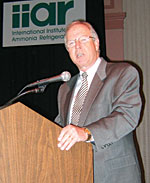
During the IIAR's business meeting at the start of the conference, Bowles, a retired Evapco executive, said the effort to link up with the Chinese refrigeration industry culminated last year when he and M. Kent Anderson, IIAR president, led a delegation to China in order "to develop a working relationship with the Chinese Association of Refrigeration and the Chinese Internal Trade Engineering Design and Research Institute; the organization responsible for the design and approval of most new industrial refrigeration facilities in China."
He said the effort included "a formal cooperative agreement between IIAR and the Chinese Association of Refrigeration" and the conducting of a refrigeration seminar for the Design Institute in Beijing.
The China connection was just one in a series of announcements made during the conference that drew close to 1,000 people.
Bowles also reported that a green paper, posted on the IIAR Website (www.iiar.org), has been developed "to convey the ammonia refrigeration story to a nontechnical audience. Its primary goal is to inform regulators and legislators of the economic and energy-efficiency advantages of ammonia refrigeration."
WORKING WITH CSB
It was also noted that IIAR has been working with the U.S. Chemical Safety and Hazard Investigation Board, which "investigates and researches a variety of industries producing and using chemicals which pose potential hazards," Bowles said."We saw early on that it was in IIAR members' best interest to work with the CSB rather than allow an adversarial atmosphere to develop. And we've been able to develop a positive and cooperative working relationship. CSB has been impressed with the activities of IIAR member companies to train, educate, and improve the safety of ammonia refrigeration systems."
REPORTING
Bowles noted that the number of ammonia release incidents reported as per requirements to the Environmental Protection Agency "has been decreasing over the 10-year period covered by the CSB's latest research (1995-2004)."But, he noted, "We have learned that approximately 25 percent of these incidents did not have to be reported at all. Some end user companies are over-reacting to legal concerns and reporting releases below required levels where there is no personal or property consequences."
He also said, "The number of releases, while at lower rates than some other chemicals, is still high enough to attract attention and require our continued reduction efforts."
PLENARY POINTS
In a plenary session, Ron Vallort, past IIAR chair, noted that while refrigeration may be a mature industry in the United States, it is still a developing industry in many parts of the world.Vallort, who is also past president of the American Society of Heating, Refrigerating, and Air-Conditioning Engineers, said he has continued to focus on the importance of the cold chain; the process that delivers products from the farm to the table. In extensive travels over the past several years, Vallort said he has seen instances of disruptions of that chain. He noted that in the country of Moldova "there were 85 cold storage facilities, but less than 10 were in working order."
One purpose of his travels was to meet with representatives of the refrigeration industry at conferences, seminars, trade shows, and informal talks to discuss ways to improve the cold chain. "Many countries are rushing to improve the infrastructure of their cold chain and raise the standard of living," said Vallort.
Along with that, he reported an emerging trend of wanting to increase energy efficiencies. He said he saw instances of the use of advanced software and microprocessors. "I found that the use of computers is common in all corners of the world," said Vallort. "I found that in many countries there is more of an emphasis on HVACR in universities than in the U.S. and there is a lot of research in ammonia and CO2 systems. "The number of practitioners is growing and as the economies continue to grow, there will be plenty of rehab and new construction going on where it is needed."
To his audience of refrigeration experts, he commented, "We must realize that we are a part of the future whether we are owners, practitioners, equipment manufacturers or government. We are the guardians of the environment as we help guide the HVACR industry."
OTHER DEVELOPMENTS
In other developments, it was reported that IIAR has completed Module Four in its safety series, which consists of a video that covers emergency response procedures. Work is continuing on the expansion of the basic ammonia refrigeration series. A new video on shut-off valves will be released in the coming months. Additional videos are planned for control valves, pumps, and vessels. Also, a proposed industrial refrigeration training guideline that was released for public review last fall is scheduled to be issued later this year.Publication date: 05/01/2006


Report Abusive Comment